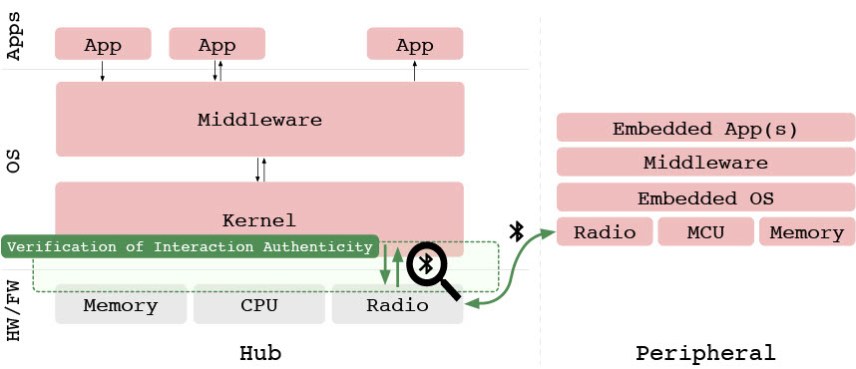At IncludeSec we of course love to hack things, but we also love to use our skills and insights into security issues to explore innovative solutions, develop tools, and share resources. In this post we share a summary of a recent paper that I published with fellow researchers in the ACM Conference on Security and Privacy in Wireless and Mobile Networks (WiSec’21). WiSec is a conference well attended by people across industry, government, and academia; it is dedicated to all aspects of security and privacy in wireless and mobile networks and their applications, mobile software platforms, Internet of Things, cyber-physical systems, usable security and privacy, biometrics, and cryptography.
Recurring Verification of Interaction Authenticity Within Bluetooth Networks
Travis Peters (Include Security), Timothy Pierson (Dartmouth College), Sougata Sen (BITS GPilani, KK Birla Goa Campus, India), José Camacho (University of Granada, Spain), and David Kotz (Dartmouth College)
The most common forms of authentication are passwords, potentially used in combination with a second factor such as a hardware token or mobile app (i.e., two-factor authentication). These approaches emphasize a one-time, initial authentication. After initial authentication, authenticated entities typically remain authenticated until an explicit deauthentication action is taken, or the authenticated session expires. Unfortunately, explicit deauthentication happens rarely, if ever. To address this issue, recent work has explored how to provide passive, continuous authentication and/or automatic de-authentication by correlating user movements and inputs with actions observed in an application (e.g., a web browser).
The issue with indefinite trust, however, goes beyond user authentication. Consider devices that pair via Bluetooth, which commonly follow the pattern of pair once, trust indefinitely. After two devices connect, those devices are bonded until a user explicitly removes the bond. This bond is likely to remain intact as long as the devices exist, or until they transfer ownership (e.g., sold or lost).
The increased adoption of (Bluetooth-enabled) IoT devices and reports of the inadequacy of their security makes indefinite trust of devices problematic. The reality of ubiquitous connectivity and frequent mobility gives rise to a myriad of opportunities for devices to be compromised. Thus, I put forth the argument with my academic research colleagues that one-time, single-factor, device-to-device authentication (i.e., an initial pairing) is not enough, and that there must exist some mechanism to frequently (re-)verify the authenticity of devices and their connections.
In our paper we propose a device-to-device recurring authentication scheme – Verification of Interaction Authenticity (VIA) – that is based on evaluating characteristics of the communications (interactions) between devices. We adapt techniques from wireless traffic analysis and intrusion detection systems to develop behavioral models that capture typical, authentic device interactions (behavior); these models enable recurring verification of device behavior.
Technical Highlights
- Our recurring authentication scheme is based on off-the-shelf machine learning classifiers (e.g., Random Forest, k-NN) trained on characteristics extracted from Bluetooth/BLE network interactions.
- We extract model features from packet headers and payloads. Most of our analysis targets lower-level Bluetooth protocol layers, such as the HCI and L2CAP layers; higher-level BLE protocols, such as ATT, are also information-rich protocol layers. Hybrid models – combining information extracted from various protocol layers – are more complex, but may yield better results.
- We construct verification models from a combination of fine-grained and coarse-grained features, including n-grams built from deep packet inspection, protocol identifiers and packet types, packet lengths, and packet directionality (ingress vs. egress).

Other Highlights from the Paper
- We collected and presented a new, first-of-its-kind Bluetooth dataset. This dataset captures Bluetooth network traces corresponding to app-device interactions between more than 20 smart-health and smart-home devices. The dataset is open-source and available within the VM linked below.
- We enhanced open-source Bluetooth analysis software – bluepy and btsnoop – in an effort to improve the available tools for practical exploration of the Bluetooth protocol and Bluetooth-based apps.
- We presented a novel modeling technique, combined with off-the-shelf machine learning classifiers, for characterizing and verifying authentic Bluetooth/BLE app-device interactions.
- We implemented our verification scheme and evaluated our approach against a test corpus of 20 smart-home and smart-health devices. Our results show that VIA can be used for verification with an F1-score of 0.86 or better in most test cases.
To learn more, check out our paper as well as a VM pre-loaded with our code and dataset.
Reproducible Research
We are advocates for research that is impactful and reproducible. At WiSec’21 our published work was featured as one of four papers this year that obtained the official replicability badges. These badges signify that our artifacts are available, have been evaluated for accuracy, and that our results were independently reproducible. We thank the ACM the WiSec organizers for working to make sharing and reproducibility common practice in the publication process.
Next Steps
In future work we are interested in exploring a few directions:
- Continue to enhance tooling that supports Bluetooth protocol analysis for research and security assessments
- Expand our dataset to include more devices, adversarial examples, etc.
- Evaluate a real-world deployment (e.g., a smartphone-based multifactor authentication system for Bluetooth); such a deployment would enable us to evaluate practical issues such as verification latency, power consumption, and usability.
Give us a shout if you are interested in our team doing bluetooth hacks for your products!
